5.16 Genetic Engineering
Figure 5.16.1 Potato plants: One genetically engineered and healthy (left), and one infected with bacterial ring rot (right).
Please Pass the Potatoes
You might want to pass on the potato plants on the right in Figure 5.16.1. They are infected with a virus, which is quickly killing them. The potato plants on the left are healthy and productive. Why aren’t they infected with the same virus? The plants on the left have been genetically engineered to make them resistant to the virus.
What Is Genetic Engineering?
Genetic engineering is the use of technology to change the genetic makeup of living things for human purposes. Generally, the goal of genetic engineering is to modify organisms so they are more useful to humans. Genetic engineering, for example, may be used to create crops that yield more food or resist insect pests or viruses, such as the virus-resistant potatoes pictured (left) in Figure 5.16.1 . Research is also underway to use genetic engineering to cure human genetic disorders with gene therapy.
Genetic Engineering Methods
Genetic engineering uses a variety of techniques to achieve its aims. Two commonly used techniques are gene cloning and the polymerase chain reaction.
Gene Cloning
Gene cloning is the process of isolating and making copies of a gene. This is useful for many purposes. For example, gene cloning might be used to isolate and make copies of a normal gene for gene therapy. Gene cloning involves four steps: isolation, ligation, transformation, and selection.
- In the isolation step, an enzyme is used to break DNA at a specific base sequence. This is done to isolate a gene.
- During ligation, the enzyme DNA ligase combines the isolated gene with plasmid DNA from bacteria. (Plasmid DNA is circular DNA that is not part of a chromosome and can replicate independently). The DNA that results is called recombinant DNA.
- In transformation, the recombinant DNA is inserted into a living cell, usually a bacterial cell.
- Selection involves growing transformed bacteria to make sure they have the recombinant DNA. This is a necessary step because transformation is not always successful. Only bacteria that contain the recombinant DNA are selected for further use.
Polymerase Chain Reaction
The polymerase chain reaction (PCR) makes many copies of a gene or other DNA segment. This might be done in order to make large quantities of a gene for genetic testing. PCR involves three steps: denaturing, annealing, and extension. The three steps are illustrated in Figure 5.16.2. They are repeated many times in a cycle to make large quantities of the gene.
- Denaturing involves heating DNA to break the bonds holding together the two DNA strands, yielding two single strands of DNA.
- Annealing involves cooling the single strands of DNA and mixing them with short DNA segments called primers. Primers have base sequences that are complementary to segments of the single DNA strands. As a result, bonds form between the DNA strands and primers.
- Extension [or Elongation] occurs when an enzyme (Taq polymerase or Taq DNA polymerase) adds nucleotides to the primers. This produces new DNA molecules, each incorporating one of the original DNA strands.
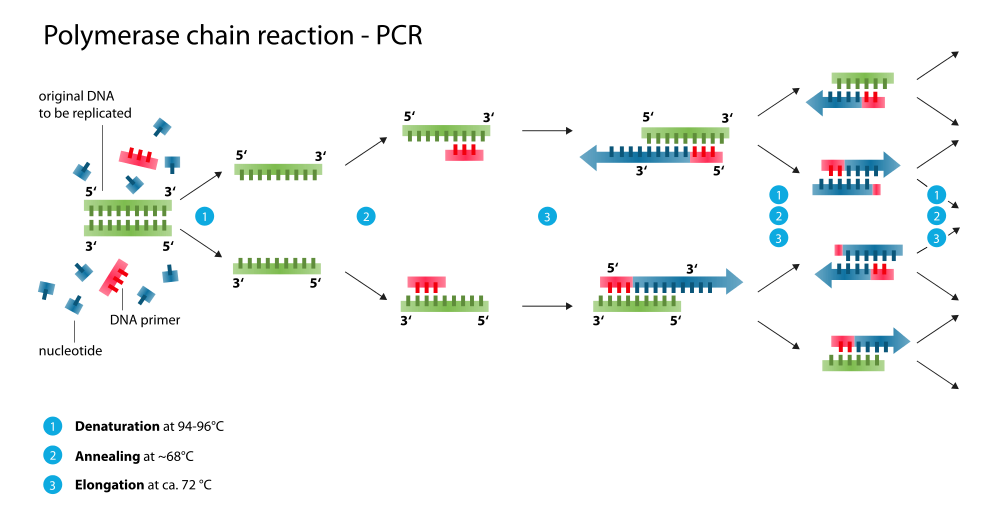
Uses of Genetic Engineering
Methods of genetic engineering can be used for many practical purposes. They are used widely in both medicine and agriculture.
Applications in Medicine
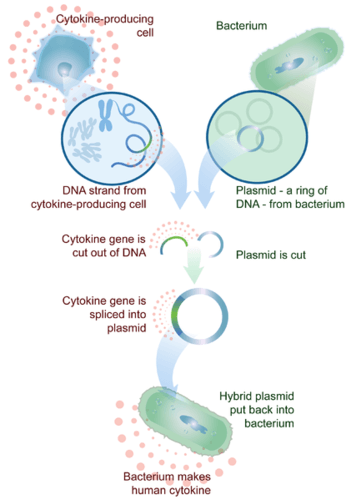
In addition to gene therapy for genetic disorders, genetic engineering can be used to transform bacteria so they are able to make human proteins (see Figure 5.16.3). Proteins made by the bacteria are injected into people who cannot produce them because of mutations.
Insulin was the first human protein to be produced in this way. Insulin helps cells take up glucose from the blood. People with type 1 diabetes have a mutation in the gene that normally codes for insulin. Without insulin, their blood glucose rises to harmfully high levels. At present, the only treatment for type 1 diabetes is the injection of insulin from outside sources. Until recently, there was no known way to make human insulin outside the human body. The problem was solved by gene cloning. The human insulin gene was cloned and used to transform bacterial cells, which could then produce large quantities of human insulin.
Applications in Agriculture
Genetic engineering has been used to create transgenic crops. Transgenic crops are genetically modified with new genes that code for traits useful to humans.
Transgenic crops have been created with a variety of different traits. They can yield more food, taste better, survive drought, tolerate salty soil, and resist insect pests, among other things. Scientists have even created a transgenic purple tomato (Figure 5.16.4) that contains high levels of cancer-fighting compounds called antioxidants.

Ethical, Legal, and Social Issues
The use of genetic engineering has raised a number of ethical, legal, and social issues. Here are just a few:
- Who owns genetically modified organisms (such as bacteria)? Can such organisms be patented like inventions?
- Are genetically modified foods safe to eat? Might they have harmful effects on the people who consume them?
- Are genetically engineered crops safe for the environment? Might they harm other organisms — or even entire ecosystems?
- Who controls a person’s genetic information? What safeguards ensure that the information is kept private?
- How far should we go to ensure that children are free of mutations?
This example shows how complex such issues may be:

A strain of corn has been created with a gene that encodes a natural pesticide. On the positive side, the transgenic corn is not eaten by insects, so there is more corn for people to eat. The corn also doesn’t need to be sprayed with chemical pesticides, which can harm people and other living things. On the negative side, the transgenic corn has been shown to cross-pollinate nearby milkweed plants. Offspring of the cross-pollinated milkweed plants are now known to be toxic to monarch butterfly caterpillars that depend on them for food. Scientists are concerned that this may threaten the monarch species, as well as other species that normally eat monarchs.
As this example shows, the pros of genetic engineering may be obvious, but the cons may not be known until it is too late, and the damage has already been done. Unforeseen harm may be done to people, other species, and entire ecosystems. No doubt the ethical, legal, and social issues raised by genetic engineering will be debated for decades to come.
Feature: Reliable Sources
Genetically modified foods (or GM foods) are foods produced from genetically modified organisms. These are organisms that have had changes introduced into their DNA using methods of genetic engineering. Commercial sale of GM foods began in 1994, with a tomato that had delayed ripening. By 2015, three major crops grown in the U.S. were raised mainly from GM seeds, including field corn, soybeans, and cotton. Many other crops were also raised from GM seeds, ranging from a variety of vegetables to sugar beets. Other sources of GM foods in our diet include meats, eggs, and dairy products from animals that have eaten GM feed, as well as a plethora of food products that contain some form of soy or corn products, such as soybean oil, soybean flour, corn oil, corn starch, and corn syrup. A quick glance at the ingredients list of most processed foods shows that these products are added to many of the items in a typical American diet.
Most scientists think that GM foods are not necessarily any riskier to human health than conventional foods. Nonetheless, in many countries, including the U.S., GM foods are given more rigorous evaluations than conventional foods. For example, GM foods are assessed for toxicity, ability to cause allergic reactions, and stability of inserted genes. GM crops are also evaluated for possible environmental effects, such as outcrossing, which is the migration of genes from GM plants to conventional crops or wild plant species.
Despite the extra measures used to evaluate GM foods, there is a lot of public concern about them, including whether they are safe for human health, how they are labeled, and their environmental impacts. These concerns are based on a number of factors, such as the worrying belief that scientists are creating entirely new species, and a perceived lack of benefits to the consumer of GM foods. People may also doubt the validity of risk assessments, especially with regard to long-term effects. Lack of labeling of GM foods is also an issue because it denies consumers the choice of buying GM or conventional foods.
Find reliable online sources about GM foods. Look for information to answer the questions below. Make sure you evaluate the nature of the sources when you assess the reliability of the information they provide. Consider whether the sources may have a vested interest in one side of the issue or another. For example, major chemical companies might promote the use of seeds for crops that have been genetically engineered to be herbicide tolerant. Why? Because it boosts the use of the weed-killing chemical herbicides they produce and sell.
- In what ways are crops modified genetically? What traits are introduced, and what methods are used to introduce them?
- What are the main human safety questions about GM foods? How is the human safety of GM foods assessed?
- What are the main environmental concerns about GM crops? How is risk assessment for the environment performed?
- What are the major pros and cons of GM crops and foods? Who is most affected by these pros and cons? For example, for pros, do growers and marketeers receive most of the benefits, or do consumers also reap rewards?
5.16 Summary
- Genetic engineering is the use of technology to change the genetic makeup of living things for human purposes.
- Genetic engineering methods include gene cloning and the polymerase chain reaction. Gene cloning is the process of isolating and making copies of a DNA segment, such as a gene. The polymerase chain reaction makes many copies of a gene or other DNA segment.
- Genetic engineering can be used to transform bacteria so they are able to make human proteins, such as insulin. It can also be used to create transgenic crops, like crops that yield more food or resist insect pests.
- Genetic engineering has raised a number of ethical, legal, and social issues. For example, are genetically modified foods safe to eat? Who controls a person’s genetic information?
5.16 Review Questions
- Define genetic engineering
-
- What is recombinant DNA?
- Identify the steps of gene cloning.
- What is the purpose of the polymerase chain reaction?
- Make a flow chart outlining the steps involved in creating a transgenic crop.
- Explain how bacteria can be genetically engineered to produce a human protein.
- Identify an ethical, legal, or social issue raised bygenetic engineering. State your view on the issue, and develop a logical argument to support your view.
- Explain what primers are and what they do in PCR.
- The enzyme Taq polymerase was originally identified from bacteria that live in very hot environments, such as hotsprings. Why does this fact make Taq polymerase particularly useful in PCR reactions?
5.16 Explore More
What is Genetic Engineering?, Eco-Wise Videos, 2015.
Bringing biotechnology into the home: Cathal Garvey at TEDxDublin,
TEDx Talks, 2013.
Attributions
Figure 5.16.1
- Potato Plant by Lehava Maghar (Pikiwikisrael) on Wikimedia Commons via the PikiWiki – Israel free image collection project is used under a CC BY 2.5 (https://creativecommons.org/licenses/by/2.5/) license.
- Potato Plant Infected with Bacterial Ring Rot by William M. Brown Jr. on Wikimedia Commons via William M. Brown Jr., Bugwood.org via forestryimages.org is used under a CC BY 3.0 US (https://creativecommons.org/licenses/by/3.0/us/deed.en) license.
Figure 5.16.2
Polymerase_chain_reaction.svg by Enzoklop on Wikimedia Commons is used under a
CC BY-SA 3.0 (https://creativecommons.org/licenses/by-sa/3.0/deed.en) license.
Figure 5.16.3
Genetic Engineering in Medicine by CK-12 Foundation is used under a CC BY-NC 3.0 (https://creativecommons.org/licenses/by-nc/3.0/) license.
 ©CK-12 Foundation Licensed under
©CK-12 Foundation Licensed under ![]() • Terms of Use • Attribution
• Terms of Use • Attribution
Figure 5.16.4
Purple Tomato/Indigo Rose by F Delventhal on Flickr is used under a CC BY 2.0 (https://creativecommons.org/licenses/by/2.0/) license.
Figure 5.16.5
Monarch_Butterfly_and_Bumble_Bee_on_Swamp_Milkweed_(28960994212) by U.S. Fish and Wildlife Service on Wikimedia Commons is in the public domain (https://en.wikipedia.org/wiki/Public_domain).
References
Brainard, J/ CK-12 Foundation. (2016). Figure 4 Genetically engineering bacteria to produce a human protein. [digital image]. In CK-12 College Human Biology (Section 5.15) [online Flexbook]. CK12.org. https://www.ck12.org/book/ck-12-college-human-biology/section/5.15/
Eco-Wise Videos. (2015, March 28). What is genetic engineering? YouTube. https://www.youtube.com/watch?v=3IsQ92KiBwM&feature=youtu.be
TEDx Talks. (2013, October 22). Bringing biotechnology into the home: Cathal Garvey at TEDxDublin. YouTube. https://www.youtube.com/watch?v=g_ZswrLFSdo&feature=youtu.be
The part of the brain below the cerebrum and behind the brain stem that coordinates body movements.
The highly folded, thin outer layer of the cerebrum where most information processing in the brain takes place.
Biological molecules that lower amount the energy required for a reaction to occur.
A sequence of nucleotides in DNA or RNA that codes for a molecule that has a function.
A class of molecules that includes the non-steroid hormones produced by the medulla of the adrenal gland, such as adrenaline, that stimulate the fight-or-flight response.
Created by CK-12 Foundation/Adapted by Christine Miller
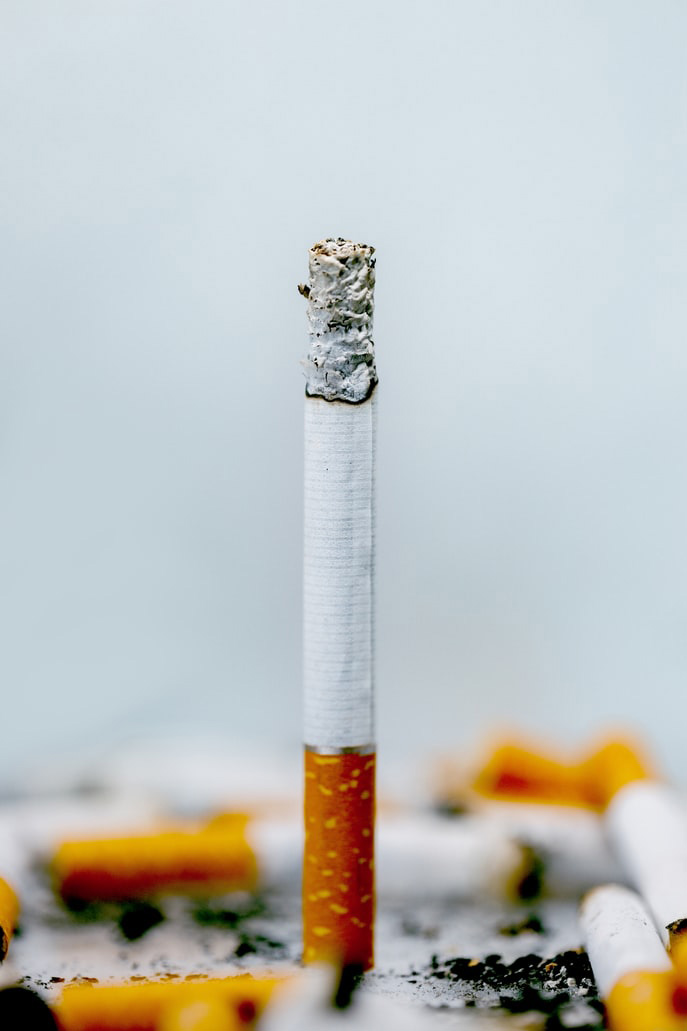
Sure Death
This anti-smoking photo (Figure 13.6.1) clearly makes the point that smoking causes death. The image is not using hyperbole, because smoking actually is deadly. It causes about 7 million deaths each year, and is the single greatest cause of preventable death worldwide. As many as half of all people who smoke tobacco die from it. As a result of smoking’s deadly effects, the life expectancy of long-term smokers is significantly less than that of non-smokers. In fact, long-term smokers can expect their lifespan to be reduced by as much as 18 years, and they are three times more likely than non-smokers to die before the age of 70.
Why Is Smoking Deadly?
As shown in Figure 13.6.2, tobacco smoking has adverse effects on just about every bodily system and organ. The detrimental health effects of smoking depend on the number of years that a person smokes and how much the person smokes. Contrary to popular belief, all forms of tobacco smoke — including smoke from cigars and tobacco pipes — have similar health risks as those of cigarette smoke. Smokeless tobacco may be less of a danger to the lungs and heart, but it, too, has serious health effects. It significantly increases the risk of cancers of the mouth and throat, among other health problems.

Even non-smokers may not be spared the deadly risks of tobacco smoke. If you spend time around smokers either at home or on the job, then you are at risk of the dangers of secondhand smoke. Secondhand smoke enters the air directly from burning cigarettes (and cigars and pipes), and indirectly from smokers' lungs. This smoke may linger in indoor air for hours, and it increases the risk of a wide range of adverse health effects. According to Health Canada, second-hand smoke causes 800 deaths from lung cancer and heart disease in non-smokers every year. The 2014 U.S. Surgeon General’s Report concluded that there is no established risk-free level of exposure to secondhand smoke. Non-smokers who are exposed to secondhand smoke may have as much as a 30 per cent increase in their risk of lung cancer and heart disease.
Tobacco contains nicotine, which is a psychoactive drug. Although nicotine in tobacco smoke does not directly cause cancer or most of the other health risks of smoking, it is a highly addictive drug. Nicotine is actually even more addictive than cocaine or heroin. The addictive nature of nicotine explains why it is so difficult for smokers to quit the habit, even when they know the health risks and really want to stop smoking. The good news is that if someone does stop smoking, his or her risks of smoking-related diseases and death soon start to fall. By one year after quitting, the risk of heart disease drops to only half of that of a continuing smoker.
Smoking and Cancer
One of the main health risks of smoking is cancer, particular cancer of the lung. Because of the increased risk of lung cancer with smoking, the risk of dying from lung cancer before age 85 is more than 20 times higher for a male smoker than for a male non-smoker. As the rate of smoking increases, so does the rate of lung cancer deaths, although the effects of smoking on lung cancer deaths can take up to 20 years to manifest themselves, as shown in Figure 13.6.3. Besides lung cancer, several other forms of cancer are also significantly more likely in smokers than non-smokers, including cancers of the kidney, larynx, mouth, lip, tongue, throat, bladder, esophagus, pancreas, and stomach. Unfortunately, many of these cancers have extremely low cure rates.
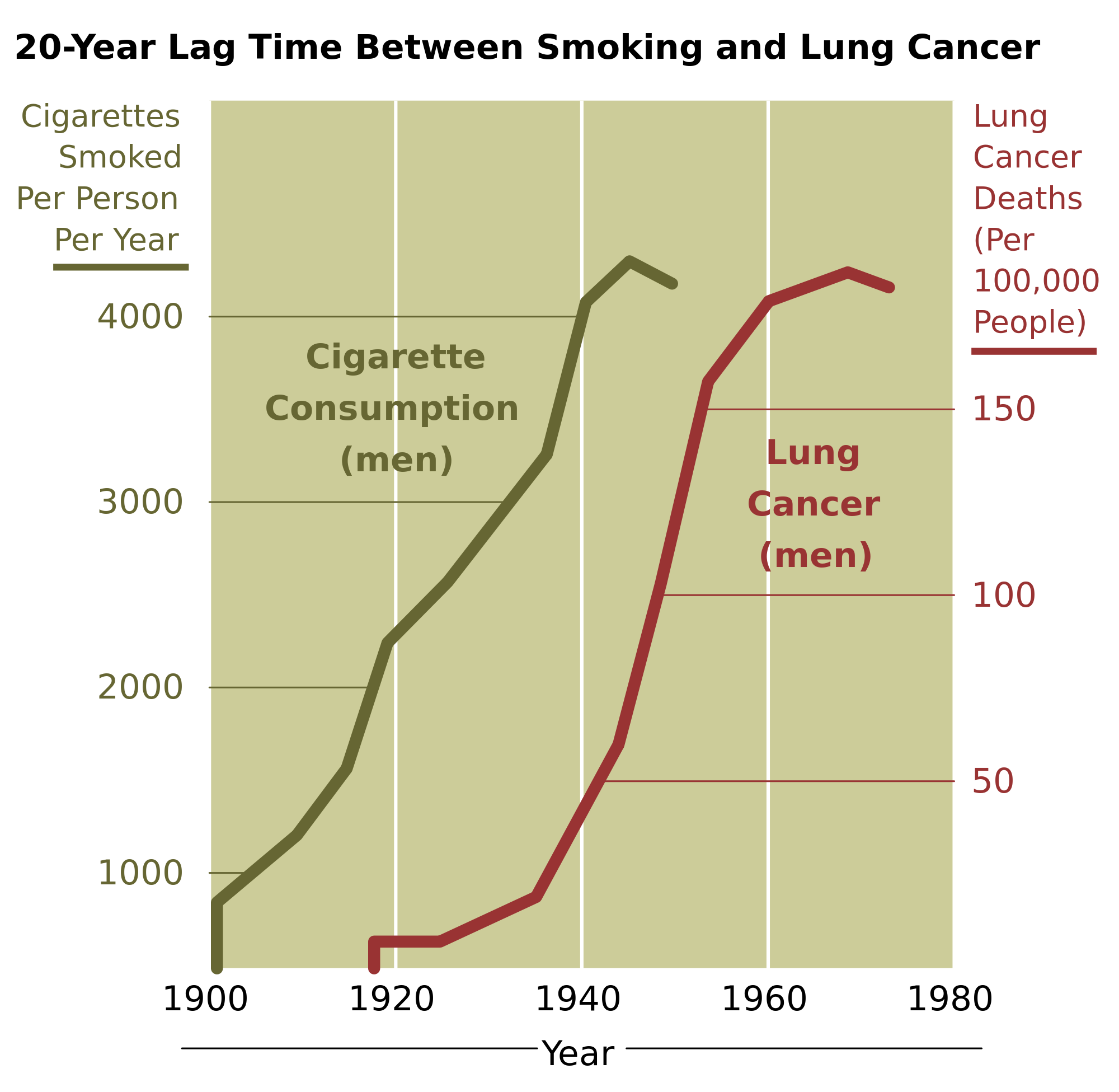
When you consider the composition of tobacco smoke, it’s not surprising that it increases the risk of cancer. Tobacco smoke contains dozens of chemicals proven to be carcinogens, or causes of cancer. Many of these chemicals bind to DNA in a smoker’s cells, and may either kill the cells or cause mutations. If the mutations inhibit programmed cell death, the cells can survive to become cancer cells. Some of the most potent carcinogens in tobacco smoke include benzopyrene, acrolein, and nitrosamines. Other carcinogens in tobacco smoke are radioactive isotopes, including lead-210 and polonium-210.
Respiratory Effects of Smoking
Long-term exposure to the compounds found in cigarette smoke — such as carbon monoxide and cyanide — are thought to be responsible for much of the lung damage caused by smoking. These chemicals reduce the elasticity of alveoli, leading to chronic obstructive pulmonary disease (COPD). COPD is a permanent, incurable, and often fatal reduction in the capacity of the lungs, reducing the lungs' ability to fully exhale air. The chronic inflammation that is also present in COPD is exacerbated by the tobacco smoke carcinogen acrolein and its derivatives. COPD is almost completely preventable simply by not smoking and by also avoiding secondhand smoke.
Cardiovascular Effects of Smoking
Inhalation of tobacco smoke causes several immediate responses in the heart and blood vessels. Within one minute of inhalation of smoke, the heart rate begins to rise, increasing by as much as 30 per cent during the first ten minutes of smoking. Carbon monoxide in tobacco smoke binds with hemoglobin in red blood cells, thereby reducing the blood’s ability to carry oxygen. Hemoglobin bound to carbon monoxide forms such a stable complex that it may result in a permanent loss of red blood cell function. Several other chemicals in tobacco smoke lead to narrowing and weakening of blood vessels, as well as an increase in substances that contribute to blood clotting. These changes increase blood pressure and the chances of a blood clot forming and blocking a vessel, thereby elevating the risk of heart attack and stroke. A recent study found that smokers are five times more likely than non-smokers to have a heart attack before the age of 40.
Smoking has also been shown to have a negative impact on levels of blood lipids. Total cholesterol levels tend to be higher in smokers than non-smokers. Ratios of “good” cholesterol to “bad” cholesterol tend to be lower in smokers than non-smokers.
Additional Adverse Health Effects of Smoking
A wide diversity of additional adverse health effects are attributable to smoking. Here are just a few of them:
- Smokers are at significantly increased risk of developing chronic kidney disease (in addition to kidney cancer). For example, smoking hastens the progression of kidney damage in people with diabetes.
- People who smoke — especially the elderly — have a greater risk of influenza and other infectious diseases than non-smokers. Smoking more than 20 cigarettes a day has been found to increase the risk of infectious diseases by as much as four times the risk in non-smokers. These effects occur because of damage to both the respiratory system and the immune system.
- In addition to oral cancer, smoking causes other oral problems, including periodontitis (gum disease). Roughly half of the cases of gum inflammation are attributable to current or former smoking. This inflammation increases the risk of tooth loss, which is also higher in smokers than non-smokers. In addition, smoking stains the teeth and causes halitosis (bad breath).
- Smoking is a key cause of erectile dysfunction (ED), probably because it leads to narrowing of arteries in the penis, as it does elsewhere in the body. The incidence of ED is about 85 per cent higher in males who smoke than it is in non-smokers.
- Smoking also has adverse effects on the female reproductive system, potentially causing infertility, in part because it interferes with the body’s ability to produce estrogen. Female smokers are about 60 per cent more likely to be infertile than non-smokers. Pregnant women who smoke or are exposed to secondhand smoke have a higher risk of miscarriages and low-birth-weight infants.
- Certain therapeutic drugs, including some antidepressants and anticonvulsants, are less effective in smokers than in non-smokers. This occurs because smoking increases levels of liver enzymes that break down the drugs.
- Smoking causes an estimated ten per cent of all fire-related deaths worldwide. Smokers are also at a greater risk of dying in motor vehicle crashes and other accidents.
- Smoking leads to an increased risk of bone fractures, especially of the hip. It also leads to slower wound healing after surgery, and an increased rate of postoperative complications.
Feature: Human Biology in the News
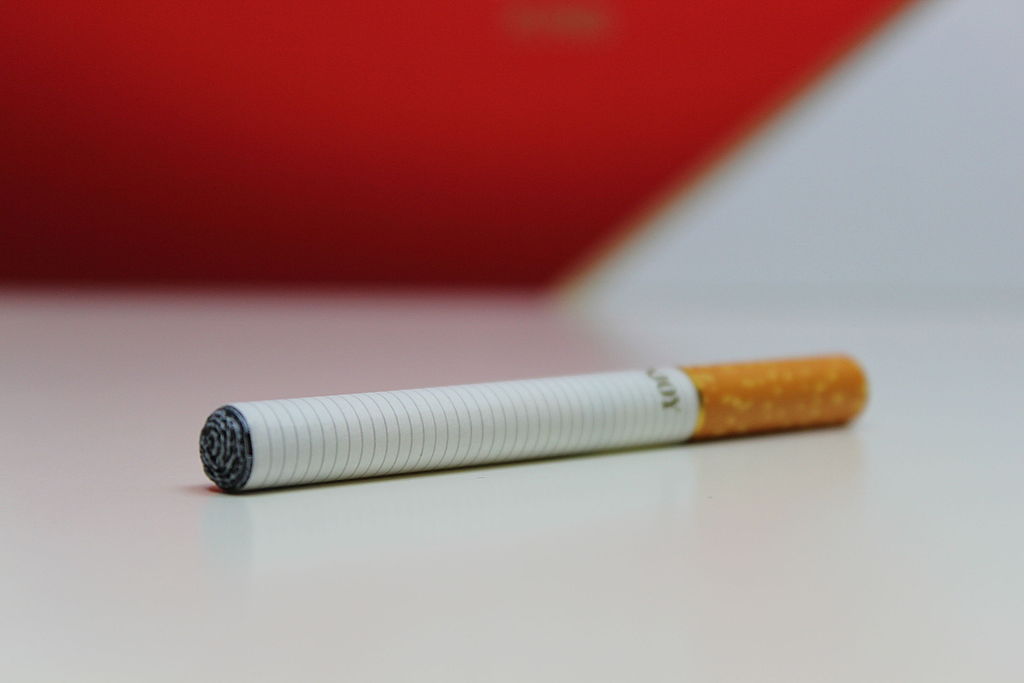
The item in Figure 13.6.4 looks like a regular cigarette, but it’s actually an electronic cigarette, or e-cigarette. E-cigarettes are battery-powered devices that change flavored liquids and nicotine into vapor that the user inhales. E-cigarettes are often promoted as being safer than traditional tobacco products, and their use is touted as a good way to quit smoking. They are often not banned in smoke-free areas, where it is illegal to smoke tobacco cigarettes.
A study completed in 2015 by researchers at the Harvard School of Public Health and widely reported in the mass media found that e-cigarettes may, in fact, be very harmful to the user’s health. E-cigarettes contain nicotine and cancer-causing chemicals, such as formaldehyde. According to the study, about three-quarters of flavored e-cigarettes also contain a chemical called diacetyl that causes an incurable and potentially fatal disorder of the lungs, commonly called “popcorn lung” (bronchiolitis obliterans). In this disorder, the bronchioles compress and narrow due to the formation of scar tissue, greatly diminishing the breathing capacity of people with the disorder. Popcorn lung gained its common name in 2004, when it was diagnosed in workers at popcorn factories. The buttery flavoring used in the factories contained diacetyl.
Some manufacturers of e-cigarettes and flavorings advertise that their products are now free of diacetyl. However, because e-cigarettes are not currently regulated by the FDA, there is no way of knowing for sure whether the products are actually safe. Equally disturbing is the appeal of flavored e-cigarettes to teens and producers' attempts to specifically market their products to this age group. Flavors such as “cotton candy,” “Katy Perry’s cherry,” and “alien blood” are obviously marketed to youth. Not surprisingly, the use of e-cigarettes is on the rise in middle and high school students, who are more likely to use them than regular cigarettes. Public health officials fear that e-cigarettes will be a gateway for teens to move on to smoking tobacco cigarettes. Some U.S. states have recently passed laws prohibiting minors from buying e-cigarettes, and Brazil, Singapore, Uruguay, and India have banned e-cigarettes. E-cigarettes were not initially regulated by Health Canada because they don't contain nicotine, which made them illegal to sell, but this was not widely enforced. However, Canada enacted the Tobacco and Vaping Products Act (TVPA) on May 23, 2018. As more questions are raised about their potential negative health effects, it is likely that more laws will be passed to regulate e-cigarettes. Watch the news for updates on this issue.
13.6 Summary
- Smoking is the single greatest cause of preventable death worldwide. It has adverse effects on just about every body system and organ. Tobacco smoke affects not only smokers, but also non-smokers who are exposed to secondhand smoke. The nicotine in tobacco is highly addictive, making it very difficult to quit smoking.
- A major health risk of smoking is cancer of the lungs. Smoking also increases the risk of many other types of cancer. Tobacco smoke contains dozens of chemicals known as carcinogens.
- Smoking is the primary cause of chronic obstructive pulmonary disease (COPD). Chemicals such as carbon monoxide and cyanide in tobacco smoke reduce the elasticity of alveoli so the lungs can no longer fully exhale air.
- Smoking damages the cardiovascular system and increases the risk of high blood pressure, blood clots, heart attack, and stroke. Smoking also has a negative impact on levels of blood lipids.
- A wide diversity of additional adverse health effects are attributable to smoking, such as erectile dysfunction, female infertility, and slow wound healing.
13.6 Review Questions
- Create a pamphlet aimed at informing teenagers about the dangers of smoking. Include information about numbers of deaths associated with smoking, life expectancy of smokers, and long term healthy effects of smoking and exposure to second-hand smoke. Include a section on the chemicals present in tobacco smoke and e-cigarettes and some of the adverse affects associated with these chemicals.
- What smoking-related factors determine how smoking affects a smoker’s health?
- What are the two sources of secondhand cigarette smoke? How does exposure to secondhand smoke affect non-smokers?
- Why is it so difficult for smokers to quit the habit? How is their health likely to be affected by quitting?
- Why does smoking cause cancer? List five types of cancer that are significantly more likely in smokers than non-smokers.
- Explain how smoking causes COPD.
- Do you think e-cigarettes can be addictive? Explain your reasoning.
13.6 Explore More
https://www.youtube.com/watch?v=lgVvnnnawvw&feature=emb_logo
Blowing Smoke: The Lost Legacy of the Surgeon General's Report | Alan Blum | TEDxTuscaloosa, TEDx Talks, 2015.
https://www.youtube.com/watch?v=QL2-EsjfiAU
The dangers of vaping, RWJ Barnabas Health, 2019.
Attributions
Figure 13.6.1
Cigarette by Uitbundig on Unsplash is used under the Unsplash License (https://unsplash.com/license)
Figure 13.6.2
Risks_from_smoking-smoking_can_damage_every_part_of_the_body by CDC on Wikimedia Commons is in the public domain (https://en.wikipedia.org/wiki/Public_domain).
Figure 13.6.3
Cancer_smoking_lung_cancer_correlation_from_NIH.svg by Sakurambo on Wikimedia Commons is in the public domain (https://en.wikipedia.org/wiki/Public_domain).
Figure 13.6.4
An_Electronic_Cigarette_(11359245033) by Lindsay Fox from Newport beach, United States on Wikimedia Commons is used under a CC BY 2.0 (https://creativecommons.org/licenses/by/2.0) license.
References
Allen, J. G., Flanigan, S. S., LeBlanc, M., Vallarino, J., MacNaughton, P., Stewart, J. H., Christiani, D.C. (2016, June 1). Flavoring chemicals in E-Cigarettes: Diacetyl, 2,3-Pentanedione, and Acetoin in a sample of 51 products, including fruit-, candy-, and cocktail-flavored E-cigarettes [online article]. Environmental Health Perspectives, 124:733–739. https://doi.org/10.1289/ehp.1510185
Health Canada. (2015). Dangers of second-hand smoke [online article]. Government of Canada. https://www.canada.ca/en/health-canada/services/smoking-tobacco/avoid-second-hand-smoke/second-hand-smoke/dangers-second-hand-smoke.html
RWJ Barnabas Health. (2019, September 25). The dangers of vaping. YouTube. https://www.youtube.com/watch?v=QL2-EsjfiAU&feature=youtu.be
TEDx Talks. (2015, August 7). Blowing smoke: The lost legacy of the surgeon general's report | Alan Blum | TEDxTuscaloosa. https://www.youtube.com/watch?v=lgVvnnnawvw&feature=youtu.be
Tobacco and Vaping Products Act. (2016, June 26). Government of Canada. https://www.canada.ca/en/health-canada/services/health-concerns/tobacco/legislation/federal-laws/tobacco-act.html
Vaping, E-cigarettes to be regulated by Health Canada. (2016, November 22). CBC/Radio-Canada. HTTP://www.cbc.ca/news/health/vaping-health-canada-legislation-1.3862589
Wikipedia contributors. (2020, August 9). Regulation of electronic cigarettes. In Wikipedia. https://en.wikipedia.org/w/index.php?title=Regulation_of_electronic_cigarettes&oldid=972059825
Created by CK-12 Foundation/Adapted by Christine Miller

Case Study: Flight Risk
Nineteen-year-old Malcolm is about to take his first plane flight. Shortly after he boards the plane and sits down, a man in his late sixties sits next to him in the aisle seat. About half an hour after the plane takes off, the pilot announces that she is turning the seat belt light off, and that it is safe to move around the cabin.
The man in the aisle seat — who has introduced himself to Malcolm as Willie — immediately unbuckles his seat belt and paces up and down the aisle a few times before returning to his seat. After about 45 minutes, Willie gets up again, walks some more, then sits back down and does some foot and leg exercises. After the third time Willie gets up and paces the aisles, Malcolm asks him whether he is walking so much to accumulate steps on a pedometer or fitness tracking device. Willie laughs and says no. He is actually trying to do something even more important for his health — prevent a blood clot from forming in his legs.
Willie explains that he has a chronic condition: heart failure. Although it sounds scary, his condition is currently well-managed, and he is able to lead a relatively normal lifestyle. However, it does put him at risk of developing other serious health conditions, such as deep vein thrombosis (DVT), which is when a blood clot occurs in the deep veins, usually in the legs. Air travel — and other situations where a person has to sit for a long period of time — increases the risk of DVT. Willie’s doctor said that he is healthy enough to fly, but that he should walk frequently and do leg exercises to help avoid a blood clot.
As you read this chapter, you will learn about the heart, blood vessels, and blood that make up the cardiovascular system, as well as disorders of the cardiovascular system, such as heart failure. At the end of the chapter you will learn more about why DVT occurs, why Willie has to take extra precautions when he flies, and what can be done to lower the risk of DVT and its potentially deadly consequences.
Chapter Overview: Cardiovascular System
In this chapter, you will learn about the cardiovascular system, which transports substances throughout the body. Specifically, you will learn about:
- The major components of the cardiovascular system: the heart, blood vessels, and blood.
- The functions of the cardiovascular system, including transporting needed substances (such as oxygen and nutrients) to the cells of the body, and picking up waste products.
- How blood is oxygenated through the pulmonary circulation, which transports blood between the heart and lungs.
- How blood is circulated throughout the body through the systemic circulation.
- The components of blood — including plasma, red blood cells, white blood cells, and platelets — and their specific functions.
- Types of blood vessels — including arteries, veins, and capillaries — and their functions, similarities, and differences.
- The structure of the heart, how it pumps blood, and how contractions of the heart are controlled.
- What blood pressure is and how it is regulated.
- Blood disorders, including anemia, HIV, and leukemia.
- Cardiovascular diseases (including heart attack, stroke, and angina), and the risk factors and precursors — such as high blood pressure and atherosclerosis — that contribute to them.
As you read the chapter, think about the following questions:
- What is heart failure?Why do you think it increases the risk of DVT?
- What is a blood clot? What are possible health consequences of blood clots?
- Why do you think sitting for long periods of time increases the risk of DVT? Why does walking and exercising the legs help reduce this risk?
Attribution
Figure 14.1.1
aircraft-1583871_1920 [photo] by olivier89 from Pixabay is used under the Pixabay License (https://pixabay.com/de/service/license/).
Created by CK-12 Foundation/Adapted by Christine Miller

Case Study: Flight Risk
Nineteen-year-old Malcolm is about to take his first plane flight. Shortly after he boards the plane and sits down, a man in his late sixties sits next to him in the aisle seat. About half an hour after the plane takes off, the pilot announces that she is turning the seat belt light off, and that it is safe to move around the cabin.
The man in the aisle seat — who has introduced himself to Malcolm as Willie — immediately unbuckles his seat belt and paces up and down the aisle a few times before returning to his seat. After about 45 minutes, Willie gets up again, walks some more, then sits back down and does some foot and leg exercises. After the third time Willie gets up and paces the aisles, Malcolm asks him whether he is walking so much to accumulate steps on a pedometer or fitness tracking device. Willie laughs and says no. He is actually trying to do something even more important for his health — prevent a blood clot from forming in his legs.
Willie explains that he has a chronic condition: heart failure. Although it sounds scary, his condition is currently well-managed, and he is able to lead a relatively normal lifestyle. However, it does put him at risk of developing other serious health conditions, such as deep vein thrombosis (DVT), which is when a blood clot occurs in the deep veins, usually in the legs. Air travel — and other situations where a person has to sit for a long period of time — increases the risk of DVT. Willie’s doctor said that he is healthy enough to fly, but that he should walk frequently and do leg exercises to help avoid a blood clot.
As you read this chapter, you will learn about the heart, blood vessels, and blood that make up the cardiovascular system, as well as disorders of the cardiovascular system, such as heart failure. At the end of the chapter you will learn more about why DVT occurs, why Willie has to take extra precautions when he flies, and what can be done to lower the risk of DVT and its potentially deadly consequences.
Chapter Overview: Cardiovascular System
In this chapter, you will learn about the cardiovascular system, which transports substances throughout the body. Specifically, you will learn about:
- The major components of the cardiovascular system: the heart, blood vessels, and blood.
- The functions of the cardiovascular system, including transporting needed substances (such as oxygen and nutrients) to the cells of the body, and picking up waste products.
- How blood is oxygenated through the pulmonary circulation, which transports blood between the heart and lungs.
- How blood is circulated throughout the body through the systemic circulation.
- The components of blood — including plasma, red blood cells, white blood cells, and platelets — and their specific functions.
- Types of blood vessels — including arteries, veins, and capillaries — and their functions, similarities, and differences.
- The structure of the heart, how it pumps blood, and how contractions of the heart are controlled.
- What blood pressure is and how it is regulated.
- Blood disorders, including anemia, HIV, and leukemia.
- Cardiovascular diseases (including heart attack, stroke, and angina), and the risk factors and precursors — such as high blood pressure and atherosclerosis — that contribute to them.
As you read the chapter, think about the following questions:
- What is heart failure?Why do you think it increases the risk of DVT?
- What is a blood clot? What are possible health consequences of blood clots?
- Why do you think sitting for long periods of time increases the risk of DVT? Why does walking and exercising the legs help reduce this risk?
Attribution
Figure 14.1.1
aircraft-1583871_1920 [photo] by olivier89 from Pixabay is used under the Pixabay License (https://pixabay.com/de/service/license/).
Clear fluid produced by the brain that forms a thin layer within the meninges and provides protection and cushioning for the brain and spinal cord.
Image shows a drawing of the cardiovascular system. The diagram includes the heart, all veins are in blue and all arteries are in red. Diagram shows the major arteries and veins in the head, neck, arms, legs and torso.

